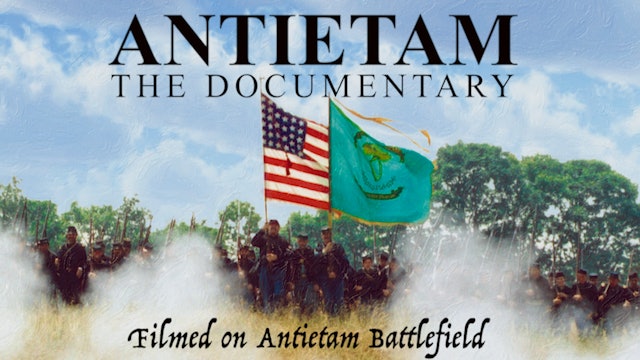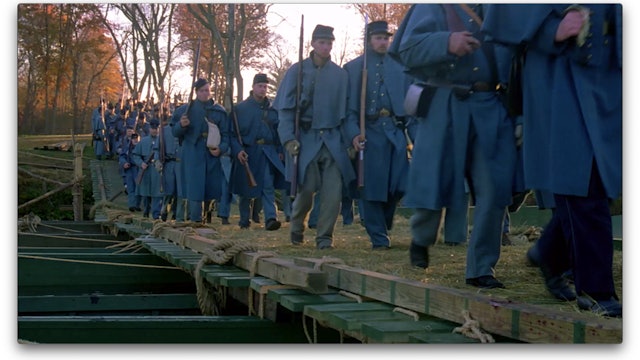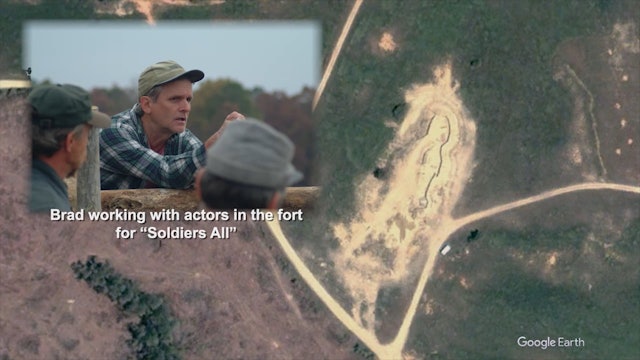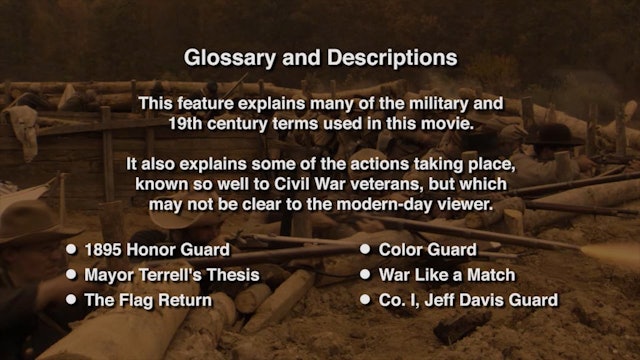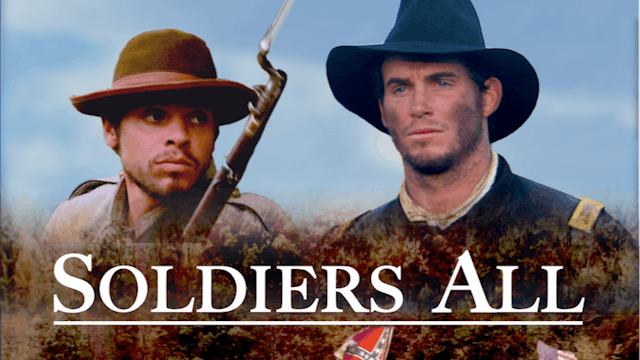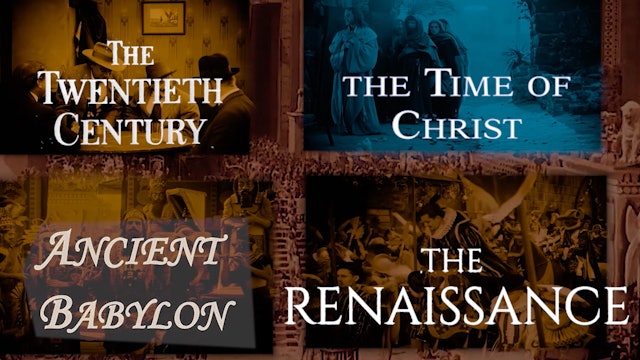-
Antietam - The Documentary Film
Unique, educational, and action-packed, Antietam, A Documentary Film was filmed on the actual Antietam battlefield and captured in 35mm motion picture film. It is narrated by James Earl Jones and includes four, on-site historians, working in pairs, two to each side, as they walk the battlefield,...
-
Chancellorsville
The most comprehensive film study of the Union Army's major attempt to win the war in the eastern theater in 1863. Filmed on the actual battlefield, and at the Claymont estate near Harpers Ferry, West Virginia, Chancellorsville brings to life Joseph Hooker's grand plan to sweep around the Confede...
-
Fredericksburg
-
Making the Pontoon Bridge for Fredericksburg
Go behind the scens to see how the pontoon bridge was made for this Fredericksburg documentary and for the movie Gods and Generals
-
The Assault on Fort Stedman
R.E. Lee’s last offensive against the Union army around Petersburg is recreated in “The Assault on Fort Stedman.” Confederate General John B. Gordon’s elaborate plan to capture a portion of the Union siege lines is explored, including the making of white strips of cloth, used to identify
Confeder... -
Intolerance Act I - Commentary
Take a short course in movie-making of the silent era, and a primer on History in four centuries. Throw in a study of American society early in the twentieth century, and get to know the actors and characters of one of the most influential movies of all time. Join film historian John O’Grady, and...
-
Symphonie Moderne for the film Four Wives 1939
Max Steiner was the father of film music as we know it. This item is particularly for my father, who became a devotee of cinematic scoring long before it was fashionable, especially the music of Max. These three pictures offer a good cross-section of his work; he also scored such disparate classi...
-
Jaromir Weinberger: Schwanda Polka & Fugue
Once a staple of Summer Band and Orchestra concerts, this oddly titled piece is something of an antiquated curiosity today. Weinberger himself was a tragic figure, who had one big hit with his Czech folk-opera Švanda Dudák in 1927 and then no more. He died forgotten in Florida in 1927 but his str...
-
Julius Ehrlich conducting the Orchestre Symphonique de Paris, 1934
There was a time when Stalin, at the peak of his power and terror, encouraged avant-garde Soviet composers to tour Europe and scare the bourgeoisie with ultra-modern, dissonant music celebrating the communist obsession with heavy industry.
But most of these composers sooner of later fell afoul of... -
Ludwig van Beethoven: Overture Leonora No.3
Toscanini in his prime was hailed as the ultimate Beethoven conductor. Not everyone agrees today, citing his relentless tempos and hard-driving intensity. But in pieces like the Fifth Symphony, or the present Overture, this style is just what is needed. Beethoven was not naturally inclined to ope...
-
Stokowski Conducting The Love for Three Oranges
Three brief orchestral numbers from Prokofiev’s bizarre fairy tale opera, conducted by a magician who delighted in bringing the new and strange to his audiences. This is perfect Stokowski material, exotic and well off the beaten path. During his years away from the Soviet Union from 1918 to 1936,...
-
Schubert’s Ave Maria – the 1918 Columbia Recording
Schubert’s Ave Maria, perhaps the best known of his over 600 songs, here played in an arrangement for violin solo by the youthful virtuoso Jascha Heifetz, then only 19.
Recorded in 1918 by Victor Records on a heavy 78 rpm disc, it was only recorded on one side; the other was left blank. It sold f... -
Richard Strauss: Don Juan
A fascinating document of Richard Strauss conducting one of his own most popular works in late Weimar-era Berlin. He was a highly un-theatrical conductor, standing very calmly and delivering the beat to the orchestra usually with one hand only. Some thought that conducting bored him, but at his b...
-
Behind the Scenes: The Earthworks for "Soldiers All"
-
Glossary of terms used in "Soldiers All"
-
Soldiers All
In the tradition of Stephen Crane's Red Badge of Courage, but with a broader sweep of time and events, Soldiers All carries the viewer from the exciting, early days of the conflict, to the grim, day-to-day battles in the trenches, and the poignant scenes of the veteran-reunions. It is the complet...
-
Intolerance Act I
Intolerance: experience this timeless masterpiece as you’ve never seen it before. Film historian John O’Grady presents Intolerance the way DW Griffith intended, with scenes, clips and even individual frames re-introduced, letting you experience the film the way people saw Intolerance when it was ...
-
Franz von Suppé: Light Cavalry Overture
Adrian Boult and the BBC Symphony Orchestra, 1934. A classic old warhorse in a great performance from the earliest days of the BBC Symphony, created largely by Boult just five years before. Composed by Francesco Ezechiele Ermenegildo de Suppé, the prolific creator of over 300 works and best known...
-
Deems Taylor: Through the Looking Glass Suite
A charming extended piece of music (about 30 minutes) by an American composer who is seldom heard nowadays, but whose music was highly popular in the 1920s and is well worth hearing now. Deems Taylor was almost a household name in those days, being prominently seen and heard in magazines and on r...
-
Rimsky-Korsakov Storm Music from "Ivan the Terrible"
Storm interlude from the opera The Maid of Pskov, also titled Ivan the Terrible. Albert Coates and the London Symphony, 1938.
A brief but wonderfully atmospheric evocation of a winter storm from a saga of Ivan the Terrible’s Russia in 1570. Conductor Albert Coates was born in St. Petersburg and ... -
Charles Gounod, Funeral March for a Marionette
Charles Gounod, Funeral March for a Marionette. Sir Henry Wood and the London Philharmonic, 1940
A droll piece of very French humor, this very popular item will be familiar to listeners today from its appropriation by Alfred Hitchcock for his television series in the 1960s. The renowned Sir Henry... -
César Franck: The Accursed Huntsman
A highly dramatic orchestral fantasy written in the old grand manner, and not as famous as it used to be, it can still be exciting and highly evocative in a good performance. This one is exceptional, with just the right orchestral balance, and very full sound just a few years before the age of th...
-
Robert Planquette: Sambre-et-Meuse March
Julius Fucik: The Entry of the Gladiators; Massed Brass Bands of the Aldershot Searchlight Military Tattoo, c.1927
Two famous marches of the nineteenth century given great effect by a huge outdoor group of band instruments. The Aldershot Tattoo was an annual event for many years, an institution o... -
Liszt’s Hungarian Rhapsody No. 2
Liszt’s Second Hungarian Rhapsody in a classic orchestral arrangement by Karl Müller-Berghaus from 1870, and recorded by Leopold Stokowski and the Philadelphia Orchestra in 1936. This was the first record my father ever purchased, in a record store in Brooklyn in 1937. It came in a plain brown pa...


